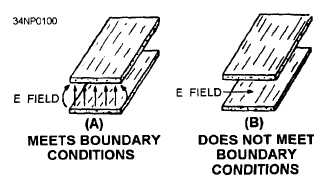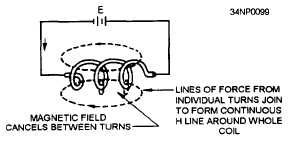Figure 3-24.—Simple electric fields.
Figure 3-25.—Magnetic field on a single wire.
the H lines take opposite directions between adjacent
turns, the field between the turns is canceled. Inside
and outside the coil, where the direction of each H
field is the same, the fields join and form continuous
H lines around the entire coil. A similar action takes
place in a waveguide.
Figure 3-26.—Magnetic field on a coil.
BOUNDARY CONDITIONS IN
A WAVEGUIDE
The travel of energy down a waveguide is similar,
but not identical, to the travel of electromagnetic waves
in free space. The difference is that the energy in a
waveguide is confined to the physical limits of the
guide.
Two conditions, known as BOUNDARY
CONDITIONS, must be satisfied for energy to travel
through a waveguide.
The first boundary condition (illustrated in fig.
3-27, view A can be stated as follows:
For an electric field to exist at the surface
of a conductor, it must be perpendicular
to the conductor.
The
in view
Figure 3-27.—E field boundary condition.
opposite of this boundary condition, shown
B, is also true. An electric field CANNOT
exist parallel to a perfect conductor.
The second boundary condition, which is illustrated
in figure 3-28, can be stated as follows:
For a varying magnetic field to exist, it must
form closed loops in parallel with the
conductors and be perpendicular to the
electric field.
3-13








